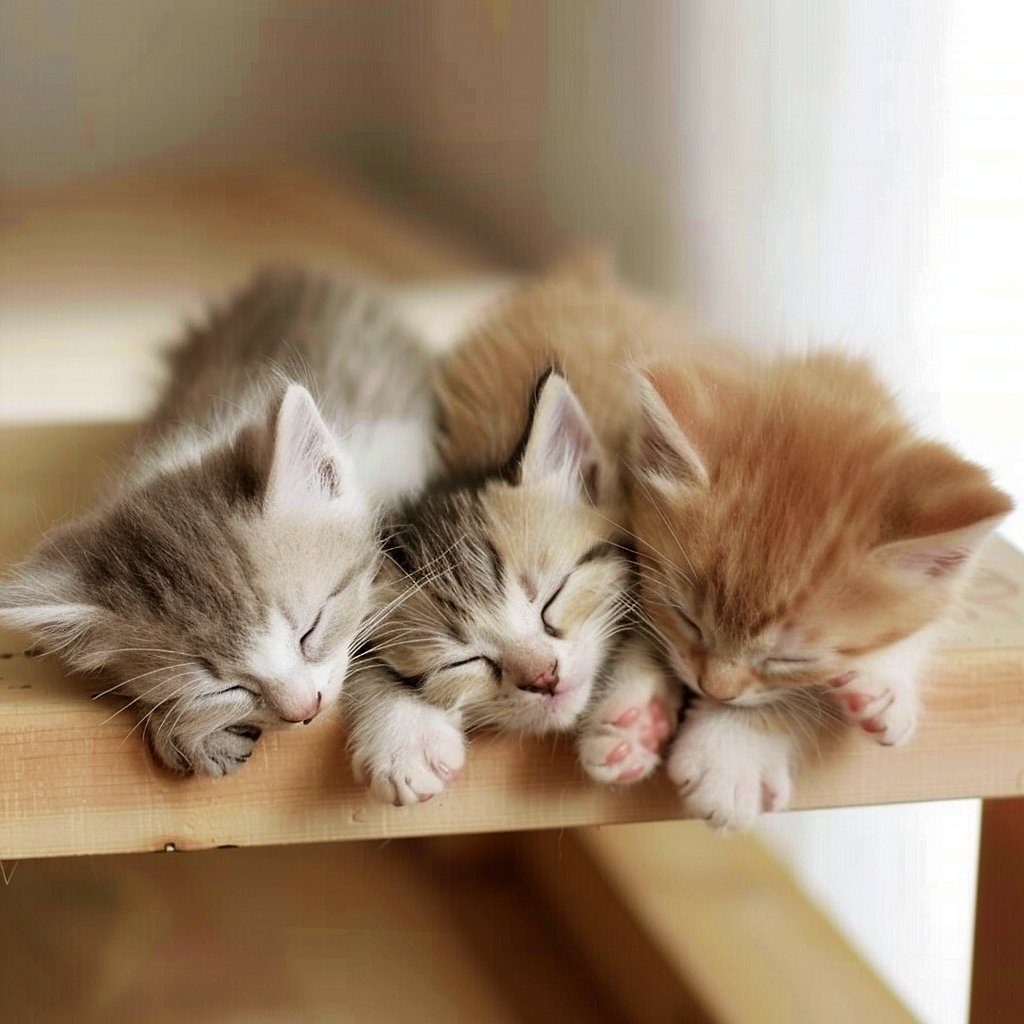Feeding your cat the right diet is essential for its health and well-being.
Fresh food for cats can provide superior nutrition compared to traditional dry or canned options.
This leads to better digestion, energy levels, and overall quality of life.
With an increasing number of fresh cat food delivery services available, it’s easier than ever to get high-quality meals right at your doorstep.
Fresh cat food is made from human-grade ingredients, often including meats, fish, and vegetables that can cater to your feline friend’s dietary needs.
Transitioning to fresh food can be a straightforward process.
There are various types to choose from, ensuring that even the pickiest eaters can find something they enjoy.
As you explore the options, consider how fresh food aligns with your cat’s nutrition and health goals.
As you dive deeper into the world of fresh cat food, you’ll find practical tips on choosing the best products and understanding their benefits.
With so many convenient delivery services to choose from, you can easily commit to a healthier diet for your furry companion without hassle.
Key Takeaways
- Fresh cat food enhances your pet’s nutrition and health.
- There are many options available to cater to picky eaters.
- Delivery services make it easy to provide fresh meals consistently.
Understanding Cat Nutrition
When considering the nutrition of cats, it’s crucial to focus on the balance of essential nutrients.
Cats are obligate carnivores, meaning their diet should primarily consist of animal-based ingredients.
This section will cover essential nutrients and how different components impact your cat’s health.
Essential Nutrients for Feline Health
Cats require several key nutrients for optimal health. Amino acids are indispensable.
The body cannot synthesize certain amino acids, so a diet rich in animal proteins is vital.
These include taurine, which supports heart function and vision, and arginine, crucial for healthy metabolic processes.
Fatty acids like omega-3 and omega-6 also play important roles.
They contribute to skin and coat health and support inflammation control.
Make sure your cat’s diet includes fat-soluble vitamins (A, D, E, K) to promote overall well-being.
Lastly, ensure adequate vitamins and minerals, like calcium and phosphorus, which are essential for bone health and metabolic functions.
The Role of Animal Protein in Cat Diet
Given that cats are obligate carnivores, animal protein should be the cornerstone of their diet.
Animal protein not only provides necessary amino acids but also supports muscle maintenance and overall energy levels.
Choose high-quality protein sources like chicken, turkey, or fish.
Look for foods that list whole meats or meat meals as primary ingredients.
This ensures your cat receives a robust protein intake without unnecessary fillers.
It’s wise to monitor protein content on food labels.
A protein level of 30-40% in dry food is typical for adult cats.
This maintains good health, promotes a healthy weight, and encourages an active lifestyle.
Carbohydrates and Grains in Cat Food
While cats don’t require carbohydrates in their diet, some cat foods contain them as fillers.
Grains like corn and wheat can serve as sources of energy but may not be necessary.
If you’re considering a grain-free diet, there are plenty of options available.
Instead, focus on simpler carbohydrates like sweet potatoes or peas, which can provide fiber and aid digestion.
Be cautious of high carbohydrate levels in some commercial cat foods.
A low-carb diet may help manage weight and support healthy blood sugar levels.
Always check the ingredients and nutritional labels to ensure your cat gets the right balance.
Hydration and Moisture Content
Hydration is often overlooked in feline nutrition.
Cats naturally have a low thirst drive because their ancestors derived moisture from prey.
Thus, incorporating moisture-rich foods is key.
Canned or fresh food typically has higher moisture content compared to dry food.
This helps to maintain urinary tract health and support kidney function.
Ideally, aim for a moisture content of 70-80% in their diet.
If your cat only eats dry food, encourage water intake by offering fresh water at all times or considering a water fountain.
This can help prevent urinary issues, which are common in felines.
The Advantages of Fresh Cat Food
Fresh cat food offers distinct benefits that contribute to your cat’s overall health and well-being.
Choosing a diet made from high-quality, human-grade ingredients can lead to better digestion, weight management, and fewer health issues.
Health Benefits of a Fresh Diet
Feeding your cat fresh food not only provides essential nutrients but also enhances their health.
Many fresh cat food options use high-quality proteins and non-GMO ingredients.
This means your cat gets a balanced diet without harmful preservatives.
Fresh diets can improve hydration, particularly if your cat prefers moist foods.
You may also notice a positive impact on their skin, coat, and energy levels.
Additionally, the natural fibers in fresh food promote better digestion, helping to reduce gastrointestinal issues and support a healthy weight.
Comparison with Commercial Cat Food
When comparing fresh cat food to commercial options, the differences become quite clear.
Commercial cat food often contains fillers and artificial additives, which aren’t ideal for your pet’s health.
In contrast, fresh options focus on real meats and veggies, giving your cat the healthiest cat food choice.
While some commercial brands claim to be nutritious, check their labels for ingredient quality.
Fresh food usually avoids preservatives, ensuring your cat is eating a meal that’s both safe and nutritious.
Considering these factors, it’s easy to see why fresh food can be a better option for many cat owners.
Understanding Fresh Food Labels
Navigating fresh cat food labels can be tricky but is essential for making informed choices.
Look for products that emphasize human-grade ingredients and high-quality protein sources.
Avoid anything with vague terms or that doesn’t specify the type of meat used.
The labels should also indicate whether the food is non-GMO and free from harmful additives.
Pay attention to the nutritional breakdown; this information helps ensure you’re providing a balanced diet.
Understanding labels empowers you as a pet owner to provide the best nutrition for your furry friend.
Types of Fresh Cat Food
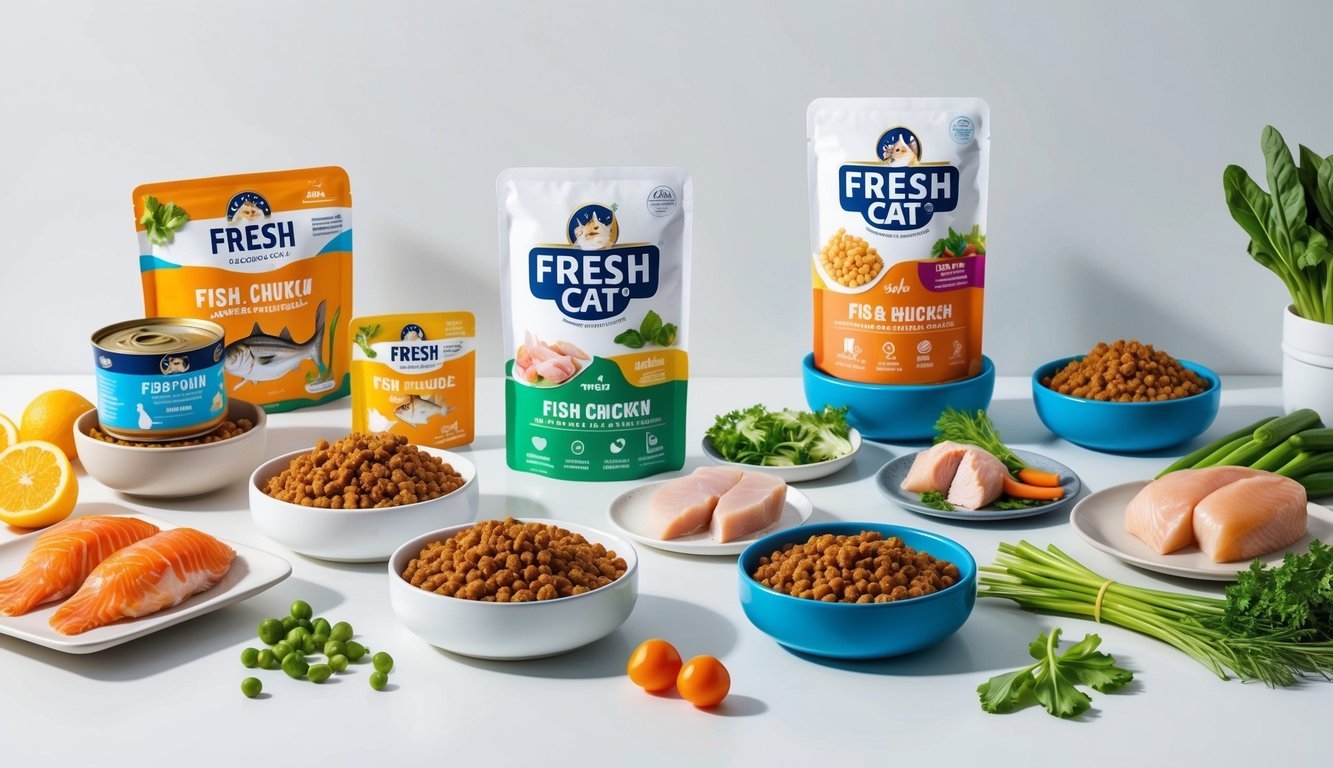
When considering fresh food for your cat, you have several options to explore.
Each type caters to different dietary needs, preferences, and health considerations.
Raw Cat Food Explained
Raw cat food is designed to mimic what your cat would eat in the wild.
It typically includes uncooked meats, organs, and sometimes bones.
This option is high in protein and often contains minimal fillers.
Pros:
- High in natural nutrients
- Promotes healthy teeth and gums
Things to consider:
- Potential for bacteria, so handling is crucial
- Requires careful nutritional balance
If you opt for raw food, ensure it’s sourced from reputable suppliers.
Some brands offer pre-prepared raw meals to simplify choosing appropriate nutrients.
The Reality of Wet and Canned Food
Wet and canned cat foods offer moisture-rich meals that can help keep your cat hydrated.
These foods come in various protein sources like chicken, fish, or beef and often contain fewer preservatives.
Benefits:
- Palatable for picky eaters
- Provides hydration along with nutrition
Considerations:
- May contain additives and fillers
- Opened cans must be refrigerated and used quickly
Popular options include brands that focus on high-quality ingredients.
Always read the labels to select those with higher meat content and fewer fillers.
Gently Cooked Cat Food Options
Gently cooked cat food is another alternative, involving low-temperature cooking methods to preserve nutrients.
This type can appeal to cats needing a cooked diet due to health issues or picky preferences.
Highlights:
- Maintains more nutrients than heavily processed foods
- Often made from fresh, human-grade ingredients
Keep in mind:
- Can be higher in cost compared to traditional kibble
- Shorter shelf life if not frozen
Brands like Smalls offer gently cooked options that include various proteins in appealing textures, making it more appealing for your cat.
Limited-Ingredient Diets for Sensitive Cats
For cats with sensitive stomachs or food allergies, limited-ingredient diets are ideal.
These foods typically contain a single protein source and a minimal number of additional ingredients.
Key Features:
- Reduces the chance of allergens triggering gastrointestinal issues
- Simplifies the ingredient list for easier digestion
Points to note:
- Always consult your veterinarian before dietary changes
- Look for quality sources of protein like fish or turkey
Some brands specialize in limited-ingredient cat food, making it easier to find a suitable option for your feline friend without unnecessary ingredients.
Choosing the Best Fresh Cat Food
Selecting high-quality fresh cat food involves understanding brands, assessing ingredients, and catering to your cat’s unique dietary needs.
This guide will help you navigate through these aspects to ensure your feline friend gets the best nutrition.
Evaluating Cat Food Brands
When looking for fresh cat food, start by researching reputable brands.
Brands like Smalls and Tom & Sawyer are known for their fresh, human-grade options.
Check for vet approvals and customer reviews.
Look for companies that emphasize transparency about sourcing and ingredient quality.
Many fresh food brands provide clear information on their manufacturing processes.
It’s beneficial to choose brands that offer a variety of proteins.
Cats can be picky, so having options like chicken, turkey, and beef can enhance palatability.
Ingredients to Look for in Fresh Cat Food
Focus on high-quality ingredients when choosing fresh food.
Look for a protein source listed as the first ingredient, such as chicken or salmon.
Avoid foods with fillers like corn or soy.
These don’t provide much nutritional value for your cat.
Instead, opt for fresh fruits and vegetables, which can offer essential vitamins and minerals.
Check for additional nutrients, like taurine, which is vital for your cat’s heart and eye health.
Ingredients should be minimally processed to preserve their nutritional content, aligning with the goal of providing your pet with fresh food.
Tailoring to Your Cat’s Specific Needs
Every cat is different, so tailoring food to their specific needs is crucial.
Consider your cat’s age, weight, and activity level.
Kittens and active cats typically require more protein than sedentary adults.
If your cat has food sensitivities or allergies, read labels for potential irritants.
Choose foods without artificial preservatives, colors, or flavors.
Consulting with your veterinarian can provide insights into your cat’s nutritional needs.
They can help you identify if a specific diet, such as grain-free or high-protein, is appropriate for your furry friend.
Delivery Services and Subscriptions
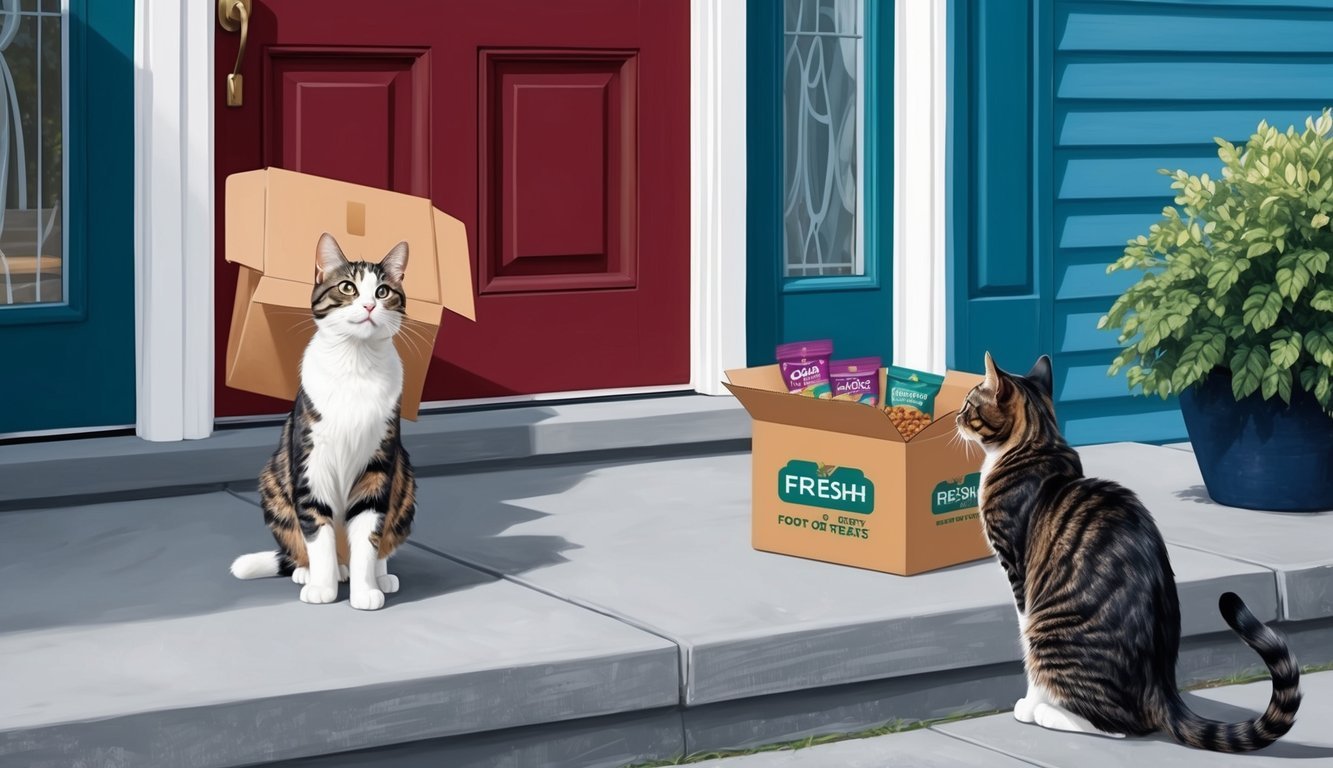
Fresh cat food delivery services offer a convenient way for you to provide nutritious meals to your feline friend.
These options make it easy to ensure your cat enjoys fresh, high-quality food tailored to their needs, all without the hassle of frequent store visits.
The Convenience of Cat Food Delivery
Cat food delivery services simplify mealtime for you and your pet.
With just a few clicks, you can order fresh food that is delivered straight to your door.
Many brands now focus on human-grade ingredients, ensuring your cat gets the nutrition they deserve.
For instance, Smalls specializes in freshly cooked cat food.
You can expect your order to arrive regularly, so you never have to worry about running out of supplies.
Subscription Services for Regular Deliveries
Subscription services mean that fresh cat food can arrive at your doorstep at the frequency you choose.
These services often allow you to customize your delivery plan based on your cat’s dietary needs and preferences.
For example, you can choose specific recipes or meal types, and some brands even provide a money-back guarantee if your cat isn’t satisfied.
This flexibility makes it easier to manage your cat’s diet, especially if they have food allergies or special requirements that necessitate tailored nutrition.
Customer Experiences and Reviews
Customer reviews play a vital role in selecting the right cat food delivery service.
Many pet owners appreciate the convenience and quality of fresh food options.
For instance, those who have tried Smalls often highlight its human-grade ingredient quality and the positive response from their cats.
Feedback on subscription services typically mentions prompt deliveries and ease of use in managing orders.
Positive experiences often underscore how quickly you can make changes to your plan, ensuring your cat always has food that suits their needs.
Be sure to read reviews to find a service that aligns with your expectations.
Compliance with Industry Standards
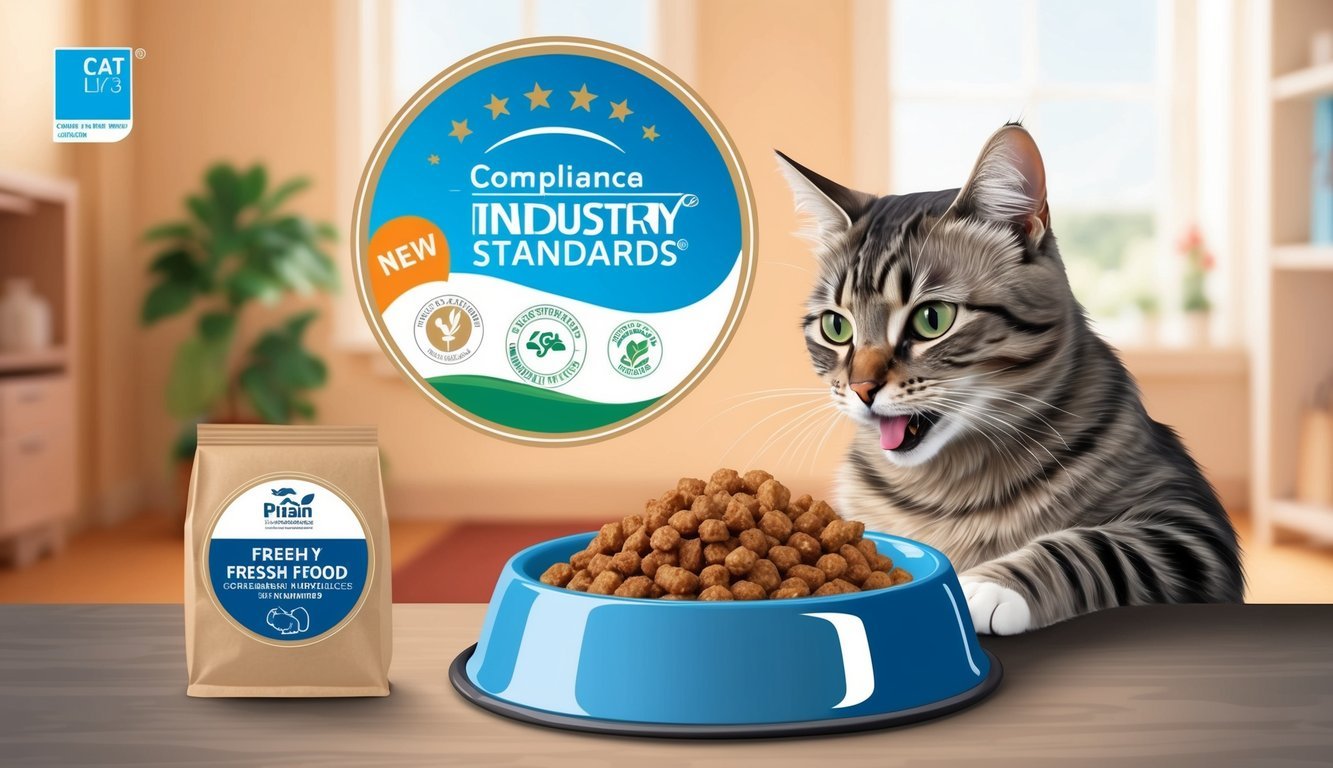
Ensuring your cat’s fresh food adheres to industry standards is crucial for their health and safety.
This compliance involves meeting guidelines set by authorities and getting input from experts in pet nutrition.
Meeting AAFCO Guidelines
The Association of American Feed Control Officials (AAFCO) establishes nutrient profiles for cat food.
When selecting fresh food, you want to ensure it meets these AAFCO guidelines to provide balanced nutrition.
What to Look For:
- Complete and Balanced Formulas: Products must provide all essential nutrients.
- Labeling Requirements: Foods should clearly state their AAFCO compliance.
To check compliance, look for claims on the packaging.
AAFCO’s approval signals that the food is formulated to meet your cat’s dietary needs, helping you make informed choices.
The Importance of Veterinary Nutritionist Approval
Veterinary nutritionists play a key role in formulating cat foods.
Their expertise ensures that your cat’s diet is not only nutritious but also safe.
Key Benefits of Consultant Approval:
- Tailored Diet Plans: Nutritionists can create specialized diets based on specific health conditions.
- Quality Assurance: Foods crafted under their guidance maintain higher standards of safety and nutrition.
When selecting fresh food, consider products endorsed by veterinary nutritionists.
Their recommendations provide peace of mind, knowing that your cat’s food is comprehensively vetted for quality and adequacy.
Feeding Practices and Techniques
When introducing fresh food into your cat’s diet, it’s essential to use proper practices and techniques.
This section will cover how to transition to fresh food, manage portion sizes, and keep an eye on your cat’s health during this change.
Transitioning to Fresh Food
Transitioning your cat to fresh food should be gradual.
Start by mixing small amounts of fresh food with their regular diet.
This method helps your cat adjust to new flavors and textures.
Consider a 7-10 day process for the transition:
- Days 1-3: Mix 25% fresh food with 75% old food.
- Days 4-6: Increase to 50% fresh food and 50% old food.
- Days 7-10: Serve 75% fresh food and 25% old food.
Watch for any digestive issues, such as upset stomach or diarrhea, and adjust the transition speed as needed.
Portion Sizing and Frequency
Portion control is crucial when feeding fresh food.
It prevents overfeeding and helps maintain optimal weight.
Cats generally need around 2-3% of their body weight in food daily.
For instance, if your cat weighs 4 kg, aim for roughly 80-120 grams of food per day.
Feeding Frequency:
- Kittens: 3-4 meals per day.
- Adults: 2 meals per day.
- Senior Cats: May benefit from 2 smaller meals.
Adjust portions based on activity level and body condition.
Monitoring Your Cat’s Health
Regular health check-ups are vital when introducing fresh food.
Keep an eye on how your cat reacts to the new diet.
This includes monitoring weight, coat condition, and energy levels.
Tracking your cat’s behavior can help you spot potential issues early.
- Signs to Watch:
- Weight loss or gain.
- Changes in litter box habits.
- Reduced energy or lethargy.
Consider consulting your veterinarian for guidance tailored to your cat’s specific health needs.
Special Considerations
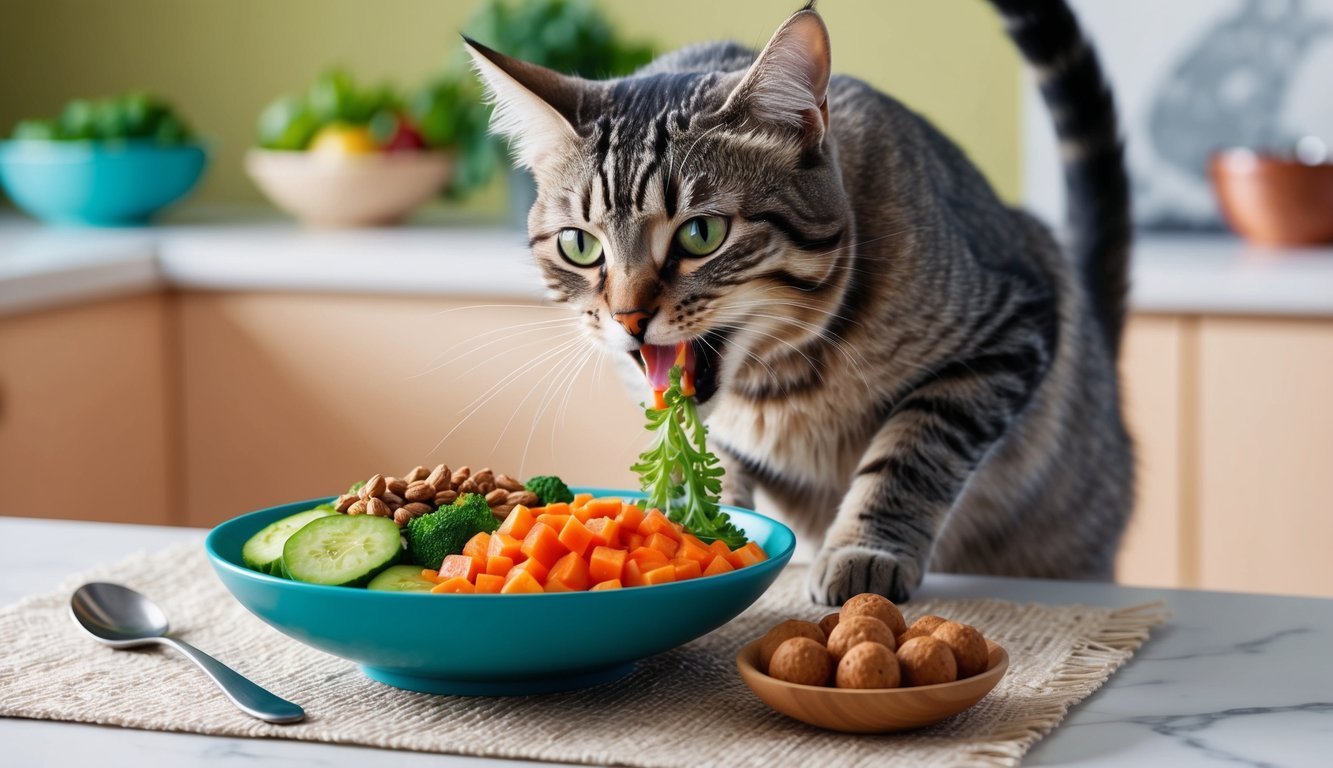
When transitioning to fresh food for your cat, it’s important to consider any medical needs, potential allergies, and weight management strategies.
Each of these factors can significantly impact your cat’s health and well-being.
Catering to Medical Needs and Conditions
If your cat has specific medical conditions, their diet may need special modifications.
For example, cats with urinary tract issues might benefit from increased moisture content, which fresh diets can provide via water-rich ingredients.
Always consult with your veterinarian before making changes.
They can suggest animal-sourced protein sources or other ingredients tailored to your cat’s health.
Including antioxidant-rich cranberries can also help promote urinary tract health, making them a smart choice for certain conditions.
Allergies and Food Intolerances
Food allergies are common among cats and may lead to skin problems or digestive issues.
It’s crucial to identify and eliminate allergens from their diet.
Common allergens include grains and artificial preservatives.
Opting for gluten-free fresh foods can help prevent allergic reactions.
Monitor your cat after introducing new ingredients and consult with a vet for guidance on safe options, ensuring that your cat receives a balanced diet without unnecessary additives.
Weight Management Through Diet
Maintaining a healthy weight is critical for your cat’s longevity and quality of life.
A fresh food diet can help by providing lower caloric density compared to many commercial options.
To manage weight effectively, measure portions and avoid free-feeding.
Incorporate healthy cat food options rich in protein while limiting high-calorie treats.
Also, avoid foods with artificial flavors as they often add extra calories with little nutritional benefit.
You might consider using a feeding schedule that aligns with your cat’s energy levels, facilitating better metabolism and weight control.
Frequently Asked Questions
When it comes to fresh food for cats, you might have several questions about sourcing, preparation, and safety.
Here are some common queries to help you navigate the world of fresh feeding for your feline friend.
Where can I find fresh cat food in my area?
You can check local pet stores, specialty shops, or even farmers’ markets for fresh cat food options.
Many pet stores now offer fresh and freeze-dried foods.
Additionally, some areas have local farms that sell raw or fresh pet food.
What are the top-rated fresh foods for cats?
High-quality fresh cat foods typically include brands that use real meats, organs, and animal fats as primary ingredients.
Look for products that adhere to AAFCO guidelines and have good reviews from cat owners.
Brands like Nom Nom and Fresh Pet consistently receive positive feedback.
How can I make homemade fresh food for my cat?
To prepare homemade fresh food, use quality protein sources like chicken, turkey, or fish.
Combine the meat with appropriate vegetables and essential nutrients.
It’s crucial to consult with a veterinarian to ensure you’re meeting your cat’s dietary needs.
Is it safe to regularly feed my cat fresh food?
Yes, feeding your cat fresh food can be safe, provided it’s balanced and meets nutritional guidelines.
It’s essential to keep the food fresh and avoid any ingredients that could be harmful, like onions or garlic.
Transitioning gradually to fresh food can also help your cat adjust.
What should I look for when choosing fresh cat food?
When choosing fresh cat food, check the ingredient list for high-quality animal proteins and minimal fillers.
Ensure that the food is specifically formulated for cats and meets their life stage requirements.
Look for reputable brands that provide transparency about their sourcing and manufacturing processes.
Are there any subscription services that offer fresh cat food?
Yes, several subscription services deliver fresh cat food directly to your door.
You can customize your cat’s meals based on their dietary needs with services like Nom Nom and PetPlate.
These options can be convenient and help ensure your cat gets fresh food regularly.

